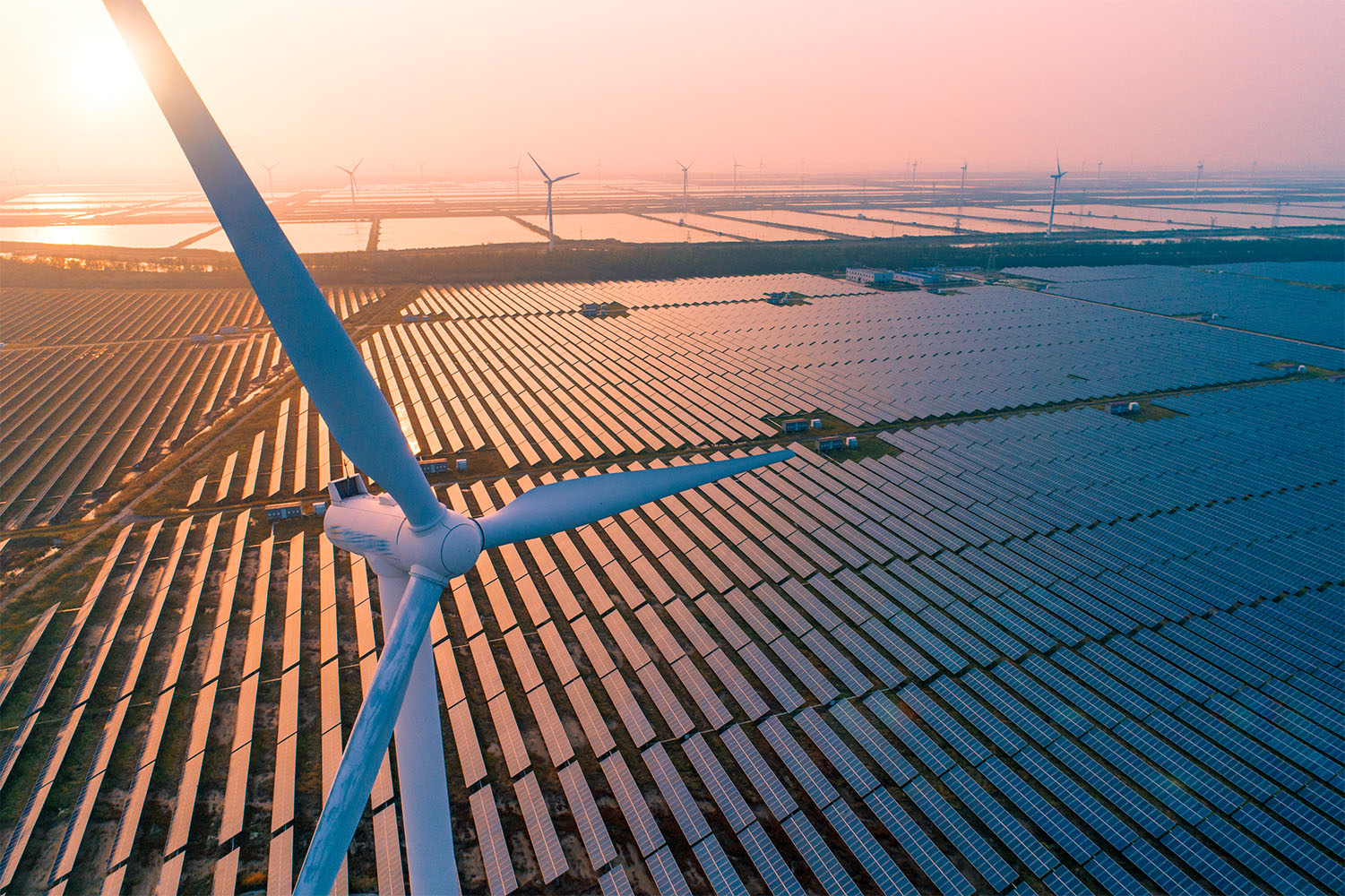UK sector pathways to net zero charted by Sixth Carbon Budget
Published on 19th May 2021
What does the Climate Change Committee recommend for individual industries in the UK?

The UK government's ambitious commitment in April 2021 to reduce net annual emissions by 78% compared to 1990 levels by 2035 – 15 years earlier than its original commitment – will hinge on a series of priorities and recommendations for each sector of the economy.
As reported in the first article in this series on the Sixth Carbon Budget and the UK's path to net zero, the UK's Climate Change Committee (CCC) has described this headline target of its December 2020 budget as "challenging" but "feasible". But the committee believes that clear, effective and fair "bottom up" policy for each sector can successfully drive the UK and its sectors on this path to net zero.
With the government's adoption of the budget – which sets out the volume of greenhouse gas (GHG) emissions the UK can emit during the period 2033-2037 – and the CCC's publication of its report on policy changes needed to meet the budget, the policy now laid out for the UK economy will require sectors and industries to make much of this change over the next five years.
As the balanced net-zero pathway – the basis for the budget's recommendation – aims to achieve 60% of planned reductions over the in the next 15 years, systematic changes will be required in business (and consumer) behaviour, energy systems and land use, with the CCC clear that success will be contingent on decisive action being taken across every sector of the economy in the 2020s.
All UK sectors that will need to contribute to the UK's balanced pathway are identified by the CCC report. For many sectors, the shape of the overall trajectory of their emissions reductions will remain similar under the different options that are identified and deployed, although the scenarios for agriculture, land use, aviation and greenhouse gas will have the most variation and the choices made in these sectors the greatest impact on the UK’s GHG emissions in 2050.
Our opening piece on the UK's pathway to net zero looked at financing, the delivery of a "just" transition in the 2020s, and actions needed over the decade and beyond. What then specifically does the CCC's balanced pathway mean for individual sectors and what are its recommendations for each industry?
Surface transport
Emissions in this sector comprise 22% of total UK greenhouse gas emissions in 2019. By following the balanced pathway, surface transport emissions will fall by around 70% by 2035 and by more than 99% by 2050. This pathway requires a reduction in car travel, a high take-up of electric vehicles (EVs), decarbonised heavy goods vehicles, reduction in van uses, and for bus and rail to become low carbon.
The reduction in car travel, for example, can be achieved through shared mobility solutions and a focus on broadband rather than road building and improvements to fuel efficiency. A higher take-up of EVs by 2035 will, the CCC estimates, lead to around 28 million EVs on the road, the large proportion being battery EVs rather than plug-in hybrids. This will be supported by charging infrastructure: the most cost-effective mix is expected to focus primarily on 22kW, 50kW, 150kW and 350kW chargers.
Likewise, heavy goods vehicles will need to be decarbonised consistently with strategies in mainland Europe. The government will need to fund large-scale trials of different technologies to gain a better understanding of options: each of battery electric, hydrogen or an electric road system could play a role. HGV logistic measures such as consolidation centres, extended delivery windows, higher loading and reduced empty running will reduce total HGV miles by around 10% by 2035.
A shift in van-usage to reduce van miles by 3% by 2035. This will be achieved by last-mile deliveries by e-cargo bikes, micro-consolidation centres in urban areas, reduction in delivery failures, improved routing technologies and encouragement of "green" delivery options.
Buses and rail will continue to move to low-carbon technologies, including all new buses to be zero carbon (largely hydrogen or battery EV) by 2035 and half of the passenger rail network electrified and where it is not, diesel trains being replaced by a mix of hydrogen, battery electric and electric-hybrid trains. Together with the electrification of main freight corridors, rail emissions will fall by around 55% by 2035.
Buildings
Progress in delivering emissions reductions in building has broadly flatlined since 2015. The CCC's balanced pathway has four priorities over the coming decade: energy-efficiency plans to upgrade building, heat pumps for decarbonising space heating, the roll-out of low-carbon heat networks in heat-dense areas such as cities, and the development of the use of hydrogen.
Energy efficiency plans will be needed to upgrade all buildings to EPC C over the next 10-15 years. This will involve loft insulations rising to over 700,000 installations per year by 2025 (from the current figure of 27,000), cavity wall insulations rising to over 200,000 a year by 2025 (from the current figure of 41,000) and solid wall insulation increasing to over 250,000 a year by 2025 (from the current 11,000)
Heat pumps will be the critical technology for decarbonising space heating. Fossil fuel boilers will need to be phased out by 2033 and this is the crucial date by which heat pump supply chains will need to be scaled up sustainably. By 2030, heat-pump sales will reach just over 1 million per year with a total of 5.5 million installed by that date.
Meanwhile, low-carbon heat networks will be rolled out in heat-dense areas like cities using anchor loads such as hospitals and schools. The supply source will switch away from combined heat and power (CHP) towards low-carbon and waste heat.
Hydrogen will also have a role in heat and this will be developed through a set of trials that build on the current innovation programme.
By 2030, 37% of heat will be met by low-carbon sources (65% by heat pumps, 32% by district heating and 3% biomass. By 2050, all heat demand will be met by low-carbon sources of which 52% will be heat pumps, 42% district heat, 5% hydrogen boilers and around 1% new direct electric heating.
Manufacturing and construction
Resource and energy-efficiency in the manufacturing and construction industries will lead to the largest emissions reductions in the early 2020s. For example, there will be design optimisation to reduce material inputs, increased recycling and reuse, increasing product longevity and increased product utilisation and sharing.
From 2025, there will be a substantial scale up of infrastructure for hydrogen and carbon capture and storage (CCS) and electricity network connection capacity.
Electricity generation
The balanced pathway plan aims for electricity generation to be largely decarbonised by 2030 and completely decarbonised by 2035 with action after that date focussed on meeting rising demand with low-carbon generation.
Offshore wind will be the backbone of the system providing 265TWh of generation in 2035 and 430TWh in 2050. Solar generation will increase to 60TWh in 2035 (from the current 10TWh) and to 85TWh in 2050). On average 3GW per year each of wind and solar will need to be installed.
Some flexible low-carbon generation will be required. By 2035, 30TWh of generation will come from gas CCS, meeting 6% of demand; bioenergy with CCS will provide a further 3% and hydrogen will provide 5% of demand (20TWh). New nuclear will replace retirements of existing nuclear plants so that by 2035, nuclear capacity will total 10GW, with 8GW of that being new-build.
A flexible system will be needed to balance the grid. Flexibility will come from both demand (e.g. demand-side response and the use of surplus renewable generation to produce hydrogen) and supply (e.g. the use of electricity storage). The primary source of storage will be hydrogen, with some hydro storage and 18GW of battery storage by 2035. Demand will be managed away from peak hours by pre-heating and storage in buildings and smart charging in transport.
There will be an important role for electrolysers to produce hydrogen at low cost from surplus renewable generation. By 2035, 25% of hydrogen supply will come from electrolysis, rising to 45% by 2050.
Fuel supply
For sectors of the economy that are likely to use fuels rather than electricity, the supply will transition from fossil fuels and bioenergy (1,100TWh and 170TWh respectively in 2018) to low-carbon hydrogen and bioenergy in 2050 (425TWh).
Electrolytic hydrogen will play an important role but, in the medium term, we will also use hydrogen produced from fossil gas with CCS. Demand for hydrogen will be greatest in manufacturing, shipping and, as back-up, power generation. Smaller contributions will also come from buildings and surface transport. Imports of hydrogen will amount to 13% of total hydrogen consumption by 2050.
Bioenergy with CCS will also contribute, providing 5% of supply by 2035 and 11% by 2050. Bioenergy production will occur via a mix of supply routes with differing contributions over time. These include: solid biomass, biohydrogen, bio-jet fuel, biodiesel, heating biofuels, bioethanol, biomethane and biogas, and residual waste.
Agriculture, land use and forestry
Around 9% of agricultural land will be needed for actions to reduce emissions and sequester carbon by 2035 with 21% needed by 2050. Improvements in productivity and a trend towards less meat and dairy in diets is key to releasing land for afforestation, peatland restoration and bioenergy crops.
Aviation
The aviation sector is likely still to have positive emissions by 2050 and so residual emissions will need to be offset by greenhouse gas removals for the sector to reach net zero. The CCC anticipates that the sector will return to pre-pandemic demand levels by 2024 but thereafter demand will gradually decline (and that there is no net increase in UK airport capacity). Emissions reductions will also come from fuel efficiency improvements and sustainable aviation fuels (biofuels and carbon-neutral synthetic jet fuel produced via direct air capture of CO2 combined with low-carbon hydrogen).
Shipping
Under the balanced pathway, the CCC anticipates the shipping sector returning to pre-pandemic demand levels in 2022. Emissions will hold flat to 2030 before reducing to near zero by 2050. The UK shipping sector will outperform global shipping emissions largely through the use of zero-carbon fuels such as ammonia. Ammonia can be used by retrofitted ship engines and has higher energy density compared to hydrogen and battery-electric options.
Waste
Around 80% of the abatement to 2035 in the waste sector will be from a combination of waste prevention (for example, reducing edible food waste by just over 50% by 2030), increased recycling (around 70% of household, commercial and industrial waste will be recycled by 2030 compared to around 50% now), and banning biodegradable waste from landfill (from 2025 onwards).
By 2050, 30% of the sector's abatement will come from retrofitting CCS to the UK's fleet of energy-from-waste facilities. An additional 10% of reductions come from capturing more methane at landfills, reducing wastewater treatment emissions and improving composting.
Fluorinated gases
F-gas are man-made gases – mainly hydrofluorocarbons – that can stay in the atmosphere for centuries. Their emissions account for around 3% of total UK greenhouse gas emissions. Major sources are refrigerants, aerosols, solvents, insulating gases and blowing agents for foams and medical equipment. These emissions will be reduced by the deployment of alternatives which are already available on the market. The move will be required by legislative restrictions on the use of F-gases which are due to come into force in the UK from 2021.
Greenhouse gas removals
Engineered greenhouse gas removals – also knowns as "negative emission technologies" – will be required to offset the remaining residual emissions in the UK. Permanent carbon removal via bioenergy with carbon capture and storage (BECCS), direct air capture of CO2 with storage (DACCS) and increased use of wood in construction will all play a part.
Neither BECCS nor DACCS are currently operating at scale in the UK and so these and their supply chains will need to be scaled up – with BECCS starting in the late 2020s and DACCS in the 2030s.
Next steps
The UK government will set the Sixth Carbon Budget into law by the end of June 2021. This will need to be followed as soon as is practicable by a set of policies and proposals that demonstrably meet the budget. The committee will report on the government's progress in its next annual progress report in June 2021. These will be important steps as the UK takes up its presidency of COP26 which is taking place in November 2021.






